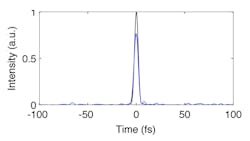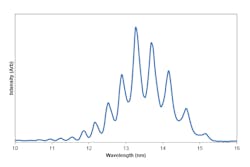Reliable 5 fs and EUV Generation with a One-Box Titanium Sapphire Amplifier
In the world of ultrafast laser amplifiers and their applications, cutting edge operating regimes such as pulse widths < 5 fs and extreme ultraviolet (EUV) wavelengths < 50 nm have only been available in specialized laboratories with extensive laser expertise. That’s because there was a marked trade-off in commercial Ti:Sapphire systems between complexity and performance. Open architecture systems enabled access to the shortest pulse widths and highest pulse energies, but these systems required a knowledgeable “laser jock” in order to obtain optimum performance. Conversely, one-box integrated amplifiers provided much simpler ease of use, but usually at the expense of achieving cutting edge performance.
Pulse widths as short as 5 fs are now routinely available using a turnkey Astrella amplifier from Coherent.
This has now changed with next-generation integrated amplifiers such as the Coherent Astrella, where higher energies and shorter pulse durations have largely closed the gap with more complex multi-box amplifiers. In conjunction with commercially available accessories, Astrella now provides turnkey access to operating parameters that were formerly only available in a handful of specialist laser labs. In this whitepaper we describe three applications that highlight the simplicity of reaching extreme performance together with industrial reliability.
A collaboration between Coherent, Professor John Tisch and Dr. Daniel Walke from Imperial College of London, and scientists from Sphere Ultrafast Photonics, shows how the Astrella amplifier to reach 5 fs pulse widths with pulse energies as high as 2 mJ.
Generation of 13.5 nm EUV using a simple combination of Coherent Astrella and a commercial HHG unit filled with helium gas.
A collaboration between Coherent and K-M Labs demonstrates how to produce EUV wavelengths as short as 10 nm. Finally a study by Professor Wei Xiong at University of California, San Diego, illustrates a demanding 2D spectroscopy experiment requiring high laser output stability for up to 40 consecutive hours.
2D spectroscopy studies using the Astrella amplifier enabled scientists to determine the orientation of a heterogeneous
CO2 reduction catalyst with potential importance in sustainable energy schemes.



